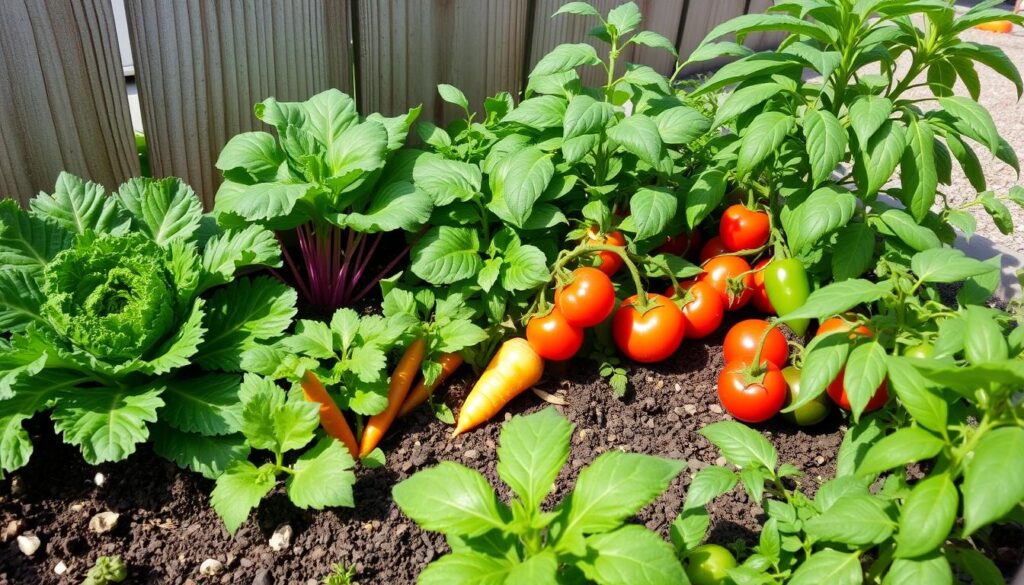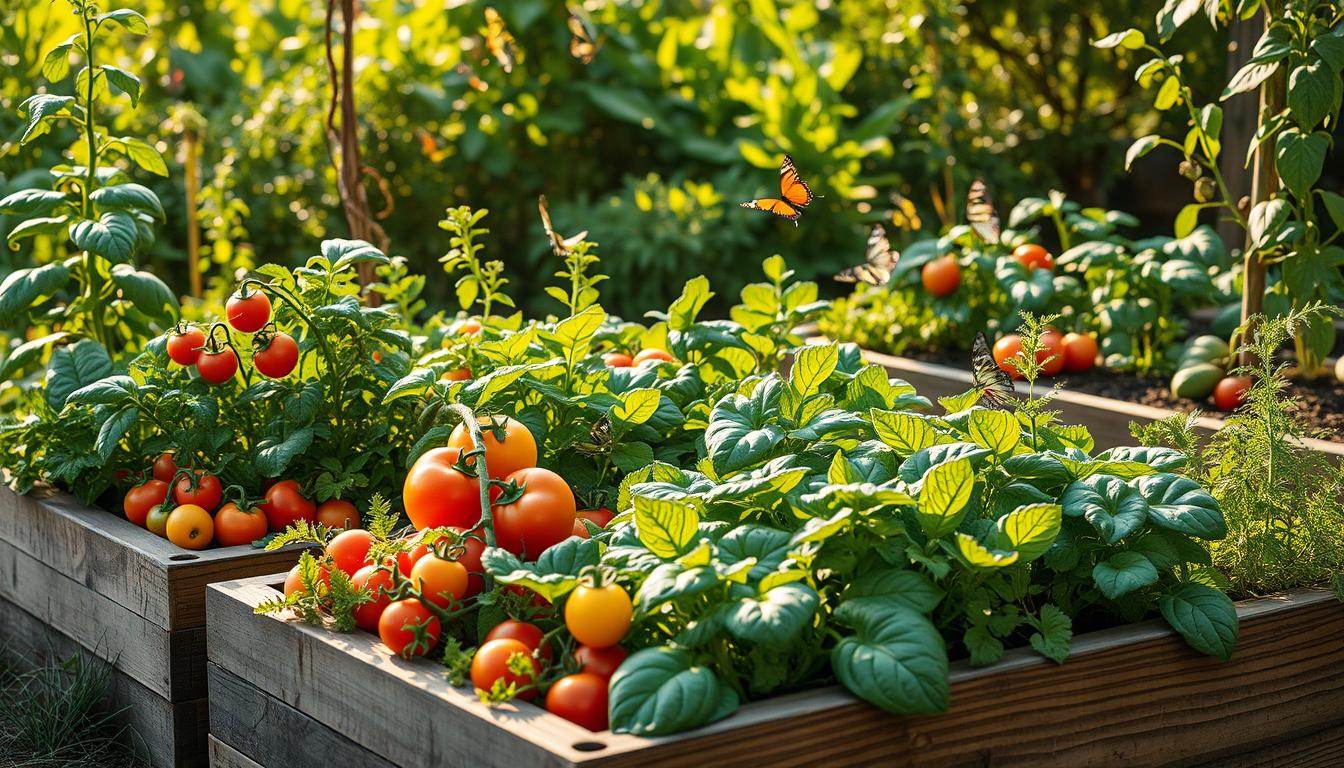In this guide, I’ll share tips to start a thriving vegetable garden, even with little space and a tight budget. You can grow your own fresh produce, no matter the size of your space. By the end, you’ll know how to create a productive and affordable garden that suits your needs.
Key Takeaways
- Maximize your available space to grow a variety of vegetables and herbs.
- Utilize budget-friendly materials and techniques to build a raised bed garden.
- Implement intensive planting methods to increase your yield in a small space.
- Create homemade compost to nourish your plants and save on fertilizer costs.
- Adopt water-wise irrigation solutions to conserve resources and reduce expenses.
Introduction: Embrace the Joy of Growing Your Own Produce
Growing your own vegetables is incredibly rewarding. It gives you fresh, healthy food and connects you to nature. It also helps the environment and makes you feel accomplished. Let’s look at why starting a small home vegetable garden is great, even with little space or money.
The benefits of home vegetable gardening are many. You get to choose what goes into your food, avoiding bad chemicals. This makes your diet healthier and more sustainable. Plus, it’s empowering to grow your own food, making you feel closer to nature.
Even with a small space, like an apartment or balcony, you can grow your own food. With some creativity and the right tips, you can have a garden that saves money and gives you fresh produce. Just remember to be patient and enjoy watching your plants grow.
“Gardening is the art of believing in tomorrow.” – Audrey Hepburn
So, whether you’re new to gardening or have been doing it for years, start a home vegetable garden. It’s a journey to self-sufficiency and a healthier life.
Plan Your Compact Garden Space
Before you start planting your small-space vegetable garden, take time to assess your area. Whether it’s a small backyard, a cozy balcony, or a compact windowsill, understanding your space is key. It helps you make the most of your limited space.
Assess Your Available Area
Look closely at the outdoor space you have. Measure it and note any obstructions like walls or fences. Also, think about how much sunlight it gets. This will help you choose the right crops for your garden.
Consider Container Gardening
If your space is very small, container gardening is a great option. Use pots, planters, or even old items to grow veggies, herbs, and even fruit trees. This method lets you be creative and flexible with your garden planning.
| Container Gardening Options | Ideal Crops |
|---|---|
| Traditional Pots | Tomatoes, peppers, herbs, leafy greens |
| Hanging Baskets | Trailing vines, strawberries, cherry tomatoes |
| Raised Beds | Root vegetables, brassicas, bush beans |
| Vertical Gardening | Cucumbers, beans, peas, small-space vines |
By planning your compact garden and using container gardening, you can have a productive garden. It doesn’t matter how small your area is.
Select Low-Cost, High-Yield Crops
Starting a vegetable garden on a tight budget means picking crops that give you the most bang for your buck. These budget-friendly vegetables and high-yield crops grow well in small areas. They provide a lot of food, making your garden both cost-effective and maximizing vegetable production.
Leafy greens like kale, spinach, and Swiss chard are great choices. They’re full of nutrients and don’t need much space or care. You can grow them in containers or small beds, perfect for small-scale gardening.
Root vegetables such as carrots, beets, and radishes are also excellent. They grow in tight spaces and give a big harvest for little space. They’re ideal for cost-effective gardening and maximizing vegetable production.
- Leafy greens: Kale, spinach, Swiss chard
- Root vegetables: Carrots, beets, radishes
- Compact varieties: Cherry tomatoes, bush beans, dwarf zucchini
Lastly, consider compact vegetable varieties for small spaces. Cherry tomatoes, bush beans, and dwarf zucchini are great. They give a lot of high-yield produce in a small area, perfect for budget-friendly gardeners.
“Grow what you love to eat and what will provide the most yield for the space you have available.”

Build Raised Beds on a Budget
Raised garden beds are great for small spaces. They let you control the growing area and use space better. You can make them cheaply using old pallets, cinder blocks, or recycled wood.
Repurpose Materials for Raised Beds
Making DIY raised garden beds is fun and budget-friendly. Here are some ways to upcycle materials for your space-saving garden beds:
- Old wooden pallets: Take apart pallets and use the wood for a bed frame.
- Cinder blocks: Stack them to make a strong, modular bed structure.
- Recycled lumber: Look for old wood like fencing or shipping crates for your beds.
Being creative with repurposed materials lets you make customized raised beds. They meet your gardening needs and budget. It’s good for your wallet and the planet.
Maximize Space with Intensive Planting Techniques
Gardening in a small space doesn’t mean you can’t have a lot of plants. Intensive planting lets you grow more in less space. This way, even tiny gardens can be very productive. Let’s look at some smart ways to use your space well.
Intercropping and Companion Planting
Intercropping means growing different plants together in the same spot. It saves space and helps plants help each other. For example, radishes grow fast and can be harvested before carrots are ready.
Companion planting is about placing plants to help each other. Some plants keep pests away, while others give shade or support. Marigolds can keep aphids off tomatoes, and pole beans can climb up corn stalks.
Using intercropping and companion planting makes your garden better and more productive. It also saves a lot of space.
| Intercropping Combinations | Companion Planting Pairings |
|---|---|
|
|
By using these techniques, you can have a garden that’s full of life and food. It will make the most of every inch of your space.
Nurture Your Garden with Homemade Compost
Healthy soil is key for a thriving garden. Making your own compost is a cost-effective way to improve it. It turns kitchen scraps and yard waste into a nutrient-rich soil amendment. This way, you can feed your plants without spending a lot on commercial fertilizers.
Creating your own compost is easy. You just need some time, basic materials, and a bit of elbow grease. The trick is to mix green (nitrogen-rich) and brown (carbon-rich) materials. This mix helps microorganisms break down the waste, making it into a nutrient-rich soil amendment.
- First, set up a compost bin or pile in a shady garden spot.
- Then, add green materials like fruit and veg scraps, coffee grounds, and grass clippings. Also, include brown materials like dried leaves, shredded paper, and straw.
- Keep turning and moistening the compost to ensure it gets enough air and water.
- After a few months, your compost will be ready. It will be a nutrient-rich addition to your garden beds.
By making your own compost, you’re on your way to a sustainable garden. It will save you money and help the environment. Start composting today and watch your garden flourish!
“Composting is one of the best things you can do for your garden – it’s like giving your plants a healthy, nutrient-rich meal.”
How to Start a Vegetable Garden with Minimal Space and Budget
Starting a vegetable garden is easy, even with little space or money. You can grow a lot of fresh food with the right plan. This guide will help you start your vegetable gardening journey.
First, check how much space you have. Small-space gardening tips suggest using containers, vertical gardens, and raised beds. These ideas help you grow food in small areas.
Choose easy-to-grow plants for your garden. Leafy greens, tomatoes, beans, and herbs are great for beginners. They grow well in small spaces and need little care.
- Use cheap materials to make your own raised beds. Try upcycled wood, cinder blocks, or old containers.
- Use intensive planting techniques like intercropping and companion planting. They help you use your space well.
- Make your own compost. It’s a cheap and green way to make your soil better.
By following these steps, you can start a budget-friendly vegetable garden. It will bring fresh food right to your door. Start your getting started with vegetable gardening journey and enjoy your homegrown food.
Water-Wise Irrigation Solutions
Keeping a vibrant vegetable garden can use a lot of water. But, there are ways to save water and keep your plants healthy. These methods help you use less water while your garden stays green and strong.
Rainwater Harvesting
Rainwater harvesting is a great way to save water. It lets you collect and store rainwater for your plants. This water is soft and full of nutrients, perfect for your garden.
Setting up a rainwater harvesting system is easy and won’t cost much. You can use a rain barrel or cistern to start collecting rainwater.
Drip Irrigation
Drip irrigation is another smart choice for saving water. It waters your plants right at their roots, cutting down on evaporation. This means every drop of water is used well.
Drip irrigation systems are easy to install and fit your garden’s needs. They’re a great option for anyone looking to save water and care for their plants.
| Irrigation Method | Water Efficiency | Installation Complexity | Maintenance Requirements |
|---|---|---|---|
| Rainwater Harvesting | High | Moderate | Low |
| Drip Irrigation | High | Moderate | Low |
| Sprinkler Systems | Low | High | Moderate |
Using rainwater harvesting and drip irrigation can make your garden water-efficient. These methods help your garden thrive while saving water and money.
Integrated Pest Management Strategies
Keeping your vegetable garden healthy doesn’t need harsh chemicals. I’ll share ways to use eco-friendly and budget-friendly methods to fight off pests. These natural, sustainable solutions help you keep your garden productive and safe for the environment.
Understanding your garden’s ecosystem is key to natural pest management. Instead of using toxic pesticides, try organic pest control methods. Encourage good bugs like ladybugs and lacewings, which eat pests. Use physical barriers like row covers or sticky traps to keep pests away.
Planting a variety of plants is another smart move. Companion planting helps keep pests away and can even make plants grow better. For example, marigolds can keep aphids and other pests from your veggies.
| Pest | Organic Control Method |
|---|---|
| Aphids | Introduce ladybugs, lacewings, or plant marigolds |
| Cucumber Beetles | Use floating row covers, hand-pick beetles, or plant radishes as a trap crop |
| Tomato Hornworms | Encourage predatory wasps, handpick caterpillars, or use bacillus thuringiensis (Bt) |
By using these integrated pest management strategies, you can keep your garden healthy and green. With a bit of creativity and focus on sustainable methods, you can have a thriving, organic pest control garden.

“The key to successful natural pest management is to work in harmony with nature, not against it.”
Extend Your Growing Season
As a small-space gardener, making the most of your space is crucial. By using smart season extension techniques, you can have a rich harvest for longer. Let’s look at some easy ways to keep your garden thriving all year, even in cold weather.
Embrace the Power of Cold Frames
Cold frames are a cheap and easy way to protect your plants. They trap heat and keep frost away, letting you start growing early and keep going into the cold months.
Leverage Row Covers for Extra Insulation
Row covers are thin, see-through fabrics you can put over your garden. They keep heat in, protect from frost, and keep pests out. This season extension technique is easy on your wallet and helps you garden all year with little effort.
Invest in a Compact Greenhouse
If you have a bit more room, a small greenhouse can change your gardening game. These structures create a warm spot for starting seeds early and growing tender veggies. Even in the coldest winters, a greenhouse can keep your garden lush. With some planning, it’s a great addition to your small garden.
“The key to successful season extension lies in understanding your local climate and selecting the right techniques to suit your needs. With a little creativity and planning, you can enjoy a bountiful harvest for months on end.”
| Season Extension Technique | Benefits | Considerations |
|---|---|---|
| Cold Frames |
|
|
| Row Covers |
|
|
| Greenhouses |
|
|
By using these season extension techniques, small-space gardeners can make the most of their gardens. Whether you choose cold frames, row covers, or a greenhouse, there’s a method for every gardener’s needs and budget.
Conclusion: Celebrate Your Homegrown Bounty
Learning to grow your own homegrown produce is rewarding and saves money. You’ve turned a small space into a lush garden-fresh vegetables haven. This journey shows you’re part of a movement that cares for the planet and controls food sources.
Enjoy the taste of your homegrown produce. It’s a reward for your hard work. Whether in a salad, soup, or as a snack, it shows your dedication to self-sufficient living.
Your garden is just the start of a sustainable future. It’s a step towards a world where you control your food and help your community. Let your homegrown produce feed your body and soul.



Leave a Reply